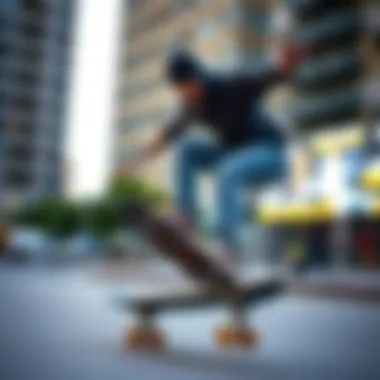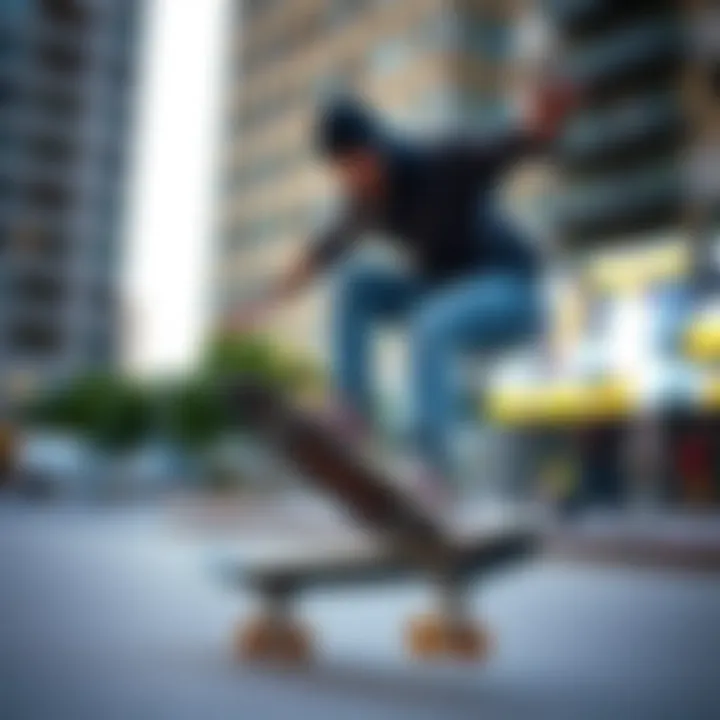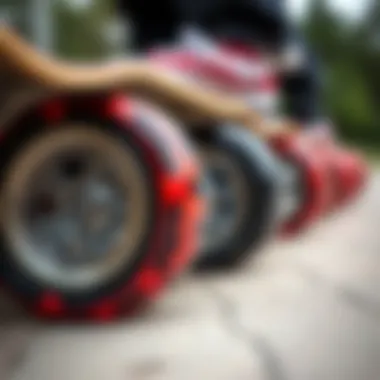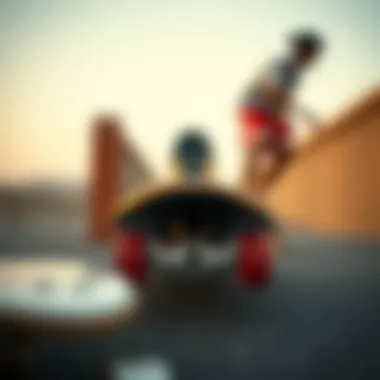Exploring the All-Star Lugged Skateboard Revolution


Intro
With the rise of skateboarding as both an art and a sport, the materials, techniques, and designs that underpin the gear used have seen significant advancements. Enter the all-star lugged skateboard, a centerpiece of innovation that bridges the gap between performance and passion. Lugged designs not only influence the board’s aesthetic but also play a crucial role in how skaters navigate obstacles, execute tricks, and express their individuality on the streets or in the park.
Skateboarding is not merely a sport; it’s a cultural phenomenon that has shaped generations. From its roots on the sun-soaked streets of California to urban parks across the globe, understanding the all-star lugged skateboard requires delving into its historical context, its present innovations, and what the future might hold. This article seeks to unravel the nuances of lugging, exploring the balance between form and function in skate design. By diving deep into the mechanics and techniques that set these boards apart, readers will glean practical insights to elevate their skating experience—whether they are novices hopping on a board for the first time or seasoned pros pushing the boundaries of what's possible in the sport.
Techniques and Tricks
To navigate the world of all-star lugged skateboards effectively, one must grasp not only the mechanics of the board but also the techniques that can enhance performance.
Basic Tricks for Beginners
For beginners, learning the ropes often starts with a few fundamental tricks that build confidence. Here are some essential techniques:
- Ollie: This basic trick involves popping the board off the ground by pressing down with your back foot while dragging your front foot up towards the nose.
- Kickflip: After mastering the ollie, skaters can move to the kickflip, which adds a flick of the foot to make the board rotate in mid-air.
- Shuvit: A simple yet stylish maneuver that rotates the board 180 degrees beneath you without flipping it.
These tricks not only increase a skater's repertoire but also provide a solid footing for more advanced techniques.
Advanced Techniques for Pro Skaters
Once a skater feels comfortable with basic tricks, the road ahead branches into advanced territory. Here are some noteworthy techniques that experienced skaters can explore:
- Heelflip: Similar to the kickflip, but instead of flicking the board with the toes, the skater uses the heel to kick the board.
- Grinds and Slides: Learning to grind edges on rails or ledges can drastically improve a skater’s street cred and technique.
- Noseblunt Slide: A trick that requires balancing on the nose of the skateboard while sliding on an object, showcasing control and style.
Mastering these tricks requires not only skill and practice but also the right gear to support the skater's movements.
Gear and Equipment
As we dive deeper into the discussion of all-star lugged skateboards, it’s important to consider the gear that complements these innovative boards.
Essential Skateboarding Gear
Every skater should be equipped with the basics to ensure safety and performance:
- Helmet: A must-have for any skater, protecting against falls.
- Grip Tape: Essential for maintaining traction between the skater’s shoes and the board.
- Wheels and Trucks: Selecting the right wheels and trucks that fit well with lugged skateboards enhances both flexibility and stability.
Latest Trends in Skate Gear
The market is buzzing with advancements in skate gear. Some trends that skaters should keep an eye on include:
- Eco-Friendly Materials: Boards crafted from sustainable sources are gaining traction, appealing to environmentally-conscious consumers.
- Customization Options: Advances in 3D printing allow for personalized designs that cater to individual skaters’ tastes and performance needs.
- Smart Technology: Some brands are incorporating technology into skateboards, like built-in sensors that track tricks and performance metrics.
The evolution of skateboarding gear reflects a commitment to balancing performance and personalization, dovetailing nicely with the culture that surrounds this dynamic sport.
Understanding these techniques and the gear at skaters' disposal can greatly enhance one's appreciation of the all-star lugged skateboard revolution. It’s about more than just riding—it's about expressing oneself, pushing boundaries, and connecting with a vibrant community.
Understanding All-Star Lugged Skateboards
In the rapidly evolving realm of skateboarding gear, understanding the nuances of all-star lugged skateboards is crucial. This segment acts as a foundation for comprehending the entire conversation surrounding modern skateboarding technology. The innovation of lugged skateboards significantly alters the landscape of performance and durability, thus making it a cornerstone topic in today's skateboarding discussions.
Lugged skateboards boast a unique construction style characterized by raised edges and grooves that allow for increased grip and stability. They cater to a wide spectrum of skateboarders, from the casual cruiser to the professional downhill racer. In this space, performance isn't just a cherry on top but an expectation, and lugged designs strive to deliver on that front.
Some specific elements of lugged skateboards include their weight distribution, which is tailored for enhanced control during tricks and turns. This balance aids in building a rider's confidence, encouraging them to push their limits. Furthermore, the materials used in these boards provide resilience against wear and tear, ensuring longevity in both urban terrains and harsh environments.
Considerations when diving into the world of lugged skateboards span across intended use and personal preference. For instance, a street skater might prioritize maneuverability and trick capability, whereas someone interested in long-distance cruising could emphasize comfort and stability. Therefore, understanding the various factors at play also offers insightful perspectives for retailers and manufacturers focusing on this specific market segment.
The significance of lugged skateboards extends beyond performance. They symbolize a shift in skateboarding culture—a movement towards personalized gear that reflects individual style and needs. As we delve deeper into defining lugged skateboards and exploring the design philosophy behind all-star models, the importance of these boards becomes increasingly clear.
"Navigating the concrete jungle is much like poetry in motion; you need the right tools to craft your verses."
There’s a growing enthusiasm within the skateboarding community regarding how these innovations blend function with artistic expression. Ultimately, exploring all-star lugged skateboards isn’t just about understanding their mechanics; it’s about embracing a revolution in how they redefine the skateboarding experience.
Historical Overview of Skateboard Design


Understanding the past of skateboard design is crucial for comprehending the trajectory towards all-star lugged skateboards and how they became pivotal in the skateboarding world. This section delves into the formative years of skateboarding, highlighting the innovations that shaped the sport and resulted in the creation of specialized gear like lugged boards. An appreciation of this history allows enthusiasts to grasp the evolution of features that enhance performance, stability, and safety.
Early Developments in Skateboarding
Skateboarding began its ride in the late 1940s and early 1950s, largely influenced by surfers wanting to mimic ocean waves on land. The first boards were essentially wooden planks with metal roller skate wheels affixed to the bottom. While rudimentary, these earliest creations laid the groundwork for future advancements in skateboard design.
In the 1960s, skateboarding gained mainstream popularity and began diversifying into various styles. One key factor was the introduction of polyurethane wheels, which revolutionized grip and ride quality. Suddenly, skaters could perform tricks and maneuvers with greater ease, fundamentally changing how skateboards were built. This industry shift opened the door to innovations like bigger and wider boards, allowing for enhanced stability and control.
Another significant moment in the early history of skateboarding was the birth of vertical skating in the 1970s. Skate parks sprung up, equipped with ramps and structures designed specifically for tricks. This era also saw the introduction of the kicktail, which allowed riders to perform ollies and other tricks that would become foundational in the sport. The transition from simple boards to more sophisticated designs illustrated a critical point in skateboarding history, showcasing how functional needs drove design evolution.
Key Developments in Early Skateboarding:
- Introduction of metal wheels (1940s)
- Emergence of polyurethane wheels (1960s)
- Development of the kicktail and wider boards (1970s)
- Growth of skate parks and vertical skateboarding
The Evolution of Skateboard Features
As skateboarding matured, so did the designs. The 1980s and 1990s marked a turning point where technological advancements became more pronounced in skateboard construction. Deck materials transitioned from wood to composite materials, including fiberglass and plastics, providing greater resilience and reducing weight.
One of the most significant innovations during this time was the development of concave decks, which provided a more ergonomic shape for riders. This shift allowed for more effective foot placement and better control over the skateboard during tricks. While previous designs focused on flat boards, the curve enabled skaters to ride with increased confidence and stability, thus enhancing performance.
Additionally, the introduction of specialized trucks designed for smooth turning and better shock absorption showcased a deeper understanding of physics at play. These innovations paves the way for the lugged boards that would emerge, integrating the performance features that skaters sought.
Milestones in Skateboard Evolution:
- Shift to composite materials (1980s)
- Incorporation of concave decks (1980s)
- Improved truck technology for enhanced performance (1990s)
- Focus on user experience and trick versatility
The historical context surrounding skateboard design not only provides insight into the innovations that have shaped modern skateboards but also underscores the dynamic nature of skateboarding as a culture and sport.
In summary, the historical overview of skateboard design encapsulates a journey from basic wooden boards to the intricacies that we see in lugged designs today. This understanding of past developments effortlessly links to the present, enabling skateboarders and enthusiasts to appreciate the sophisticated gear that enhances their experience on the pavement.
Technical Aspects of Lugged Construction
In the world of skateboarding, where every micro-second counts and performance can be affected by the slightest variables, understanding the technical aspects of lugged construction is vital. The way skateboards are built can mean the difference between a smooth ride and a tumultuous one. The lugged design isn’t just for aesthetics; it plays a crucial role in improving performance and enhancing the overall experience. With this section, we dive into the nitty-gritty of what makes these boards not only stand out but function efficiently in a range of environments.
Materials Used in Lugged Designs
The foundation of any great skateboard lies in the materials selected for its construction. Lugged skateboards utilize a blend of advanced materials to ensure durability, weight optimization, and performance. Some key materials include:
- Maple Wood: Often regarded as the backbone of skateboard decks, maple wood presents a strong yet flexible characteristic, enabling both strength and a slight give in motion. Its layers are often laminated together, improving strength considerably.
- Bamboo: Environmentally friendly and lightweight, bamboo adds a unique feel to the board, making it popular among those seeking responsiveness without excessive weight.
- Fiberglass Reinforcements: Many lugged boards incorporate fiberglass layers, which add stiffness and reduce vibration. This feature is essential for handling rugged terrain, making riders feel more in control.
- Polyurethane Wheels: The choice of wheel material affects grip and shock absorption. Companies often experiment with different durometers to find the perfect balance between softness for grip and hardness for speed.
Choosing the right material can drastically change the skateboard’s performance, leading to an overall better experience, especially in varied terrains.
The Mechanics of Lugged Boards
Understanding how lugged skateboards function mechanically can provide valuable insight into their advantages. The lugs, those little protrusions on the board, are not merely decorative; they serve specific purposes that enhance performance.
- Increased Grip: The lugs create additional contact points between the deck and the rider’s shoes. This enhances grip, allowing for tricks to be executed more uniformly and cleanly.
- Stability: The distribution of weight supported by the lugs allows for better balance. This means less wobbling while a skater performs jumps or grinds, which ultimately leads to safer rides.
- Shock Absorption: Lugs can also help in distributing the impact force upon landing. When skaters land a trick, the integrated lugs can absorb some of that shock, reducing the strain on the skateboarder’s joints and extending the lifespan of the board.
Ultimately, the mechanics behind lugged boards show that thoughtful engineering goes into skate design. They contribute to a ride that offers improved stability, enhanced control, and ultimately a better connection between the rider and their environment.
Performance Benefits of All-Star Lugged Boards
When it comes to skateboarding gear, performance is the name of the game. All-star lugged skateboards stand out because of their unique design elements that enhance riders' experience on various terrains. These boards do not just introduce fresh aesthetics; they fundamentally change how skaters interact with their environment. Let's delve into two main aspects: improved stability and control, and enhanced durability in diverse conditions.
Improved Stability and Control
One of the defining features of all-star lugged boards is their construction that significantly boosts stability and control. The lugged design involves raised edges or protrusions, which help in maintaining grip on uneven surfaces. This is particularly beneficial for urban skaters navigating cracked pavement or the ever-unpredictable skate parks.
Riders often cite an increase in confidence while making sharp turns or performing tricks. With these boards, skaters can feel the ground beneath them more effectively, allowing for micro-adjustments during rides. The gripping nature of the lugs also diminishes the risk of slipping during trick execution. Rather than worrying about losing balance, skaters can focus on the art of their maneuver.
“With my lugged board, I go deeper into turns, and I don’t feel like I’m going to wipe out,” says a seasoned skater from San Francisco, highlighting a common sentiment among users.
This enhanced control provides a smoother experience while riding downhill or at high speeds. Lugs create a unique feel where feedback from the ground translates through the board directly to the rider’s feet, a critical component that fine-tunes their riding technique.
Enhanced Durability in Diverse Conditions


Another notable benefit of all-star lugged boards lies in their durability. These boards are crafted from high-quality materials that withstand harsher conditions. Whether one is skating in rain, on rough gravel, or through the hot sun, lugged boards maintain integrity far better than traditional models.
The lugged edges provide extra protection against dings and scratches—common foes in skateboarding adventures. As riders are likely to bump into obstacles, the reinforced design helps absorb impacts, allowing the board to hold up longer without degrading performance. In terms of materials, polyurethane wheels paired with durable decks create a resilient combination that seems almost invincible to the everyday wear-and-tear.
Moreover, lugged designs cater to various skating styles, adjusting to needs whether one is attempting a grind, tackling a ramp, or just cruising in the neighborhood. Their robust construction lends them versatility across multiple settings without compromising on performance.
In the shifting landscape of skateboarding equipment, all-star lugged boards bring a compelling blend of stability and durability that appeals to skaters of all levels. Those who invest in these boards often find them to be reliable companions on their skating journeys, regardless of the terrain they encounter.
This underlines not just an evolution in design philosophy but a significant shift in how we view skateboarding gear for its performance traits, confirming that lugged technology is here to stay.
User Experience Insights
Understanding user experience insights is essential, especially in the context of all-star lugged skateboards, as these insights bridge the gap between manufacturer intentions and rider expectations. The real significance of skateboarding gear lies not solely in its specs, but in how it feels and performs under the feet of diverse skaters. Exploring what riders really think highlights the practicality and emotional connection tied to these boards, pushing the narrative beyond just numbers and material.
Skateboarder Testimonials
Testimonials from skateboarders often reveal hidden truths about how lugged boards stack up against traditional models. For instance, some riders find that the increased grip of lugged designs translates to more confidence while performing complex tricks. One avid skater from California stated, "The moment I switched to a lugged board, my landings felt more secure. It's like having a little extra push from the board itself."
These responses are not just anecdotes; they represent a growing consensus about the change in ride quality.
- Improved turning response is a frequent praise point among users.
- Users have noted that durability has been enhanced; one rider remarked that they noticed significantly less wear and tear in rough terrain after switching to a lugged model.
- Added stability, especially during trick execution, has become a common highlight in testimonials.
Clearly, the impact of these boards affects not just individual skaters but potentially enriches the skate community as a whole. It creates a snowball effect, encouraging newer skaters to try out these insights proven by peers.
Comparative Analysis with Traditional Models
In comparing lugged boards to traditional models, a clear distinction emerges in terms of design intent and functional output.
- Grip and Traction: Lugged designs usually feature deeper grooves that enhance traction on various surfaces. Traditional boards often fall short in this department, making them less suitable for different styles of skating.
- Weight and Handleability: While some might argue that traditional boards have an overall lighter feel, lugged boards often balance weight with stability. Skateboarders have indicated that the heftier feel of lugged boards makes them more controllable during aerial maneuvers.
- Durability: Traditional boards may chip or splinter easier when constantly used in harsh environments. The lugged boards are often manufactured to withstand higher impacts and rough terrain, something that skaters in urban environments fully appreciate.
- Cost Versus Benefit: Price analysis shows that although lugged boards may come with a higher price tag, the long-term benefits observed through enhanced performance often justify the expense. Riders conclude that investing in a good lugged board pays off by offering longevity and an overall better skating experience.
The way forward seems clear. Riders are beginning to prioritize performance and durability over initial costs, creating a shift in purchasing trends that manufacturers cannot ignore.
Innovations in Skateboard Technology
In the world of skateboarding, technology continually evolves, pushing the boundaries of what’s possible. The significance of innovations in skateboard technology cannot be understated, particularly when it comes to lugged designs. These advances not only enhance the riding experience but also resonate with the culture surrounding skateboarding, where innovation is as integral as the tricks themselves.
Modern skateboard design encapsulates a blend of engineering marvels and user-centered design. As skaters demand more from their boards—whether it’s durability during extreme flips or versatility on various surfaces—manufacturers have risen to the challenge. For instance, the incorporation of synthetic materials still remains prominent, offering greater shock absorption while keeping the weight down. Moreover, integrating cutting-edge manufacturing techniques ensures that each component is optimized for performance and safety.
Recent Breakthroughs in Skateboard Design
Breakthroughs in skateboard design often strike a chord among enthusiasts and newcomers alike. Two notable innovations in this realm include:
- Board Shape Optimization: Manufacturers are continually experimenting with shapes tailored for specific riding styles, from street to vert. The geometry of a lugged skateboard is adjusted based on rigorous research and input from professional skaters, leading to boards that not only feel right but perform exceptionally.
- Advanced Flex Technology: With the recent emergence of boards that incorporate varied flex patterns, riders experience improved responsiveness. Some makers utilize multi-layer constructions where the type of wood and layers are strategically placed, allowing for flexible movement that absorbs impact while providing a lively feel.
This continuous development not only improves performance but also captivates those watching and participating in the sport. A lugged board equipped with these innovations can make the difference between a mediocre ride and an exhilarating performance.
"With every evolution in design, skateboards move one step closer to perfecting not just performance, but also self-expression."
—Anonymous Skater
The Role of Technology in Lugged Skateboards
As skateboard technology advances, the role of lugging becomes increasingly critical. Lugged skateboards are particularly designed to enhance features such as grip and stability. Here’s where technology paves the path for the evolution of these boards:
- Automated Engineering Techniques: Computer-aided design (CAD) helps in crafting superior lugged boards, allowing for precision in dimensions and material usage. This tech ensures that quality control is maintained from production to retail.
- Smart Materials: Emerging smart materials respond to stress and environmental changes. For instance, some boards deploy special polymers that stiffen upon impact but return to a flexible state when idle. This adaptability ensures that skaters benefit from both durability and comfort under challenging conditions.
- Enhanced Safety Features: Modern technology enables the incorporation of safety features such as built-in sensors that detect damage and alert skaters. This can prevent accidents before they occur by encouraging timely maintenance and repair.
Lugged Boards and Skateboarding Culture
Skateboarding is more than just a sport; it represents a lifestyle, a culture that blends creativity, freedom, and community. The rise of lugged boards has significantly influenced this culture, ushering in new shapes, styles, and attitudes. In this segment, we will dive into how lugged designs intertwine with the broader tapestry of skateboarding culture and the ways they propel forward various skating styles and community dynamics.
Influences on Skateboarding Styles
Lugged boards are redefining the contours of skateboarding styles. Traditionally, skateboarding riders leaned towards narrower boards designed for specific tricks or street skating. However, lugged boards offer a broader canvas, allowing for diverse expressions and innovations in riding techniques. The lugging creates multiple contact points on the ground, which enhances grip and stability. This stability is a game-changer for skaters tackling complex tricks or transitioning between different terrains.
Moreover, the visual aesthetics of lugged boards also play a crucial role. Custom graphics and the unique silhouette of these boards can express individuality. Skateboarding is often about identity, and a rider's gear is an extension of their persona. Riders gravitating towards lugged styles may find themselves influencing or participating in subcultures that value creativity and experimentation. These boards have roots in various skateboarding sub-groups, including longboarding, downhill racing, and even freestyle, each of which resonates differently within the larger culture, promoting innovative tries.


In essence, lugged boards foster a new blend of styles, encouraging skateboarding beyond the confines of traditional limits. From weekend warriors to street skaters, the lugged boards extend invitations for all to partake.
Community Perceptions and Adoption
The acceptance of lugged boards within the skateboarding community has been a nuanced journey. While traditionalists might hold onto their tried-and-true models, many skaters are willing to experiment with lugged designs. Adoption can be influenced by factors, such as peer recommendations and exposure to successful riders championing these innovations.
Community perceptions of lugged skateboards often vary based on location and available resources. In urban settings, where maneuverability and trick finesse are key, lugged boards are met with curiosity and skepticism. Meanwhile, in more open environments, such as parks or recreational areas, the versatility and stability of lugged boards have garnered enthusiastic support.
Moreover, social media serves as a powerful tool in shaping perceptions. Skateboarders showcasing their riding style on platforms like Instagram or TikTok have a colossal impact on how new technologies are perceived. When a board breaks the internet, other riders might feel the urge to hop on the trend, potentially leading them to consider lugged options.
"Embracing the lugged boards isn’t just about choosing new patterns; it’s about diving into a culture of exploration and community that feeds on innovation."
Ultimately, the community’s pulse on lugged boards will continue to evolve. As innovators and skaters introduce new concepts, the feedback loop between users and the skateboard community will seem alive, shaping future designs while upholding the heritage that binds skaters together. The marriage of tradition with innovation may result in a fresh clarity of what it means to be a skater today.
Market Trends in Skateboarding Gear
Understanding market trends in skateboarding gear is essential for grasping how innovation and consumer behavior shape the skateboarding landscape. The rise of all-star lugged skateboards represents a significant shift in design philosophy and user preferences. These trends indicate broader societal shifts, shedding light on the values of safety, sustainability, and performance among skateboarders.
As the skateboarding community evolves, gear preferences are transitioning towards products that offer enhanced functionality and durability. Consumer feedback plays a crucial role in this, as enthusiasts increasingly seek boards that provide not only a unique aesthetic but also superior performance in various conditions. This creates a landscape where brands need to be responsive to the voices of their users.
In a marketplace brimming with choices, discerning between emerging brands and established names can be daunting for users. However, the appeal of all-star lugged skateboards has caught the eye of both seasoned skaters and newcomers alike, primarily due to their innovative features and heightened resilience, which allow skaters of any skill level to enjoy their craft without undue worry about equipment failure.
Consumer Preferences and Feedback
Consumer preferences are shifting towards boards that balance aesthetics and functionality. According to recent surveys, more skateboarders are reporting a desire for boards that not only look good but also hold up under pressure. Many users have stated that they appreciate the sturdiness and stable grip that lugged designs provide, especially in urban environments where versatility is key. Importantly, the feedback loop between consumers and brands has never been more direct, thanks to social media platforms and online forums.
- Quality vs. Price: Skateboarders lean towards items that showcase quality craftsmanship, even if that means a higher price point. They tend to prefer materials known for durability, like maple and high-grade aluminum.
- Sustainability: Consumers express interest in eco-friendly products. Brands that utilize sustainable practices and materials often receive positive feedback, thereby creating a loyal customer base.
- Performance: As more skaters experiment with tricks and styles, the demand for performance-focused boards has surged. Lugs designed for superior grip and stability allow users to express their creativity seamlessly.
"I’m willing to pay more if it means getting a board that lasts longer and performs better in different conditions," said one longtime skateboarder in a community forum.
Emerging Brands and Products
The landscape for emerging brands in skateboarding is vibrant. New companies are continuously pushing the envelope, introducing innovative products that challenge the status quo. With the rise of all-star lugged skateboards, manufacturers are now fostering a competitive spirit, leading to the creation of unique and varied products.
Some notable trends among emerging brands include:
- Customization: Many newcomers offer customizable options, allowing skateboarders to design their boards according to their personal styles and performance needs.
- Technology Integration: Companies are incorporating technology into board designs, such as integrated sensors that can track performance statistics or smart materials that respond to environmental changes.
- Community Involvement: Emerging brands often support skateboarding initiatives in their locales, fostering a community approach that resonates deeply with consumers.
Overall, staying ahead of these market trends is fundamental for retailers and brands alike. Understanding the nuances of consumer preferences and supporting the growth of emerging players can create an insightful pathway toward catching the attention of a discerning skateboarding audience.
The Future of All-Star Lugged Skateboards
When it comes to the realm of skateboarding, innovation never sleeps. The flair and functionality of all-star lugged skateboards are pivotal in shaping how skaters of all ages and skill levels engage with their boards. As we peer into the future of these remarkable pieces of gear, there's more than just the allure of new designs on the horizon. It’s about enhancing performance and fostering deeper connections within the skating community.
Skateboard technology continues to evolve, driven by both consumer wants and the push from manufacturers. There’s a distinct importance in understanding not just what’s next, but how it aligns with what skaters truly need. The ramp in interest surrounding lugged boards hints at a vibrant future where skaters are empowered by improved agility, safety, and durability, ultimately saving them from unnecessary hard knocks.
Predicted Innovations and Improvements
When considering the intricate dance between technology and artistry in skate design, we can anticipate more than a few exciting trends. Innovations likely to surface in the coming years include:
- Smart Skate Technology: Imagine boards with built-in sensors that monitor performance metrics. These would provide real-time feedback on tricks or even track wear and tear, ensuring optimal riding conditions.
- Eco-Friendly Materials: The shift towards sustainability could lead to the development of boards made from recycled or organic materials, maintaining durability without sacrificing the environment.
- Customizable Features: The future might bring boards that can be personalized with adjustable lugs for varying riding styles. This would help in aligning the board's feel with the skater's preferences.
- Enhanced Suspension Systems: As comfort is crucial, new suspension innovations could provide better shock absorption, ensuring skaters maintain control over rough terrains or during high impact tricks.
By harnessing these enhancements, lugged skateboards could redefine the skater's experience, making skating not just a sport, but a blend of technology and personal expression.
Potential Impact on Skateboarding Communities
The ripples of innovation extend far beyond someone simply enjoying a smoother ride on their board. With advancements in all-star lugged skateboards, the potential impact on skateboarding communities is notable:
"Innovations in skateboards will not only elevate the sport but redefine the community dynamic."
- Increased Accessibility: With improved technology, more individuals may find themselves drawn to skateboarding. This could lead to wider participation across diverse demographics, enhancing the community’s scope.
- Better Safety Practices: As boards become safer and more sophisticated, there may be a decline in injuries, encouraging newcomers to take up the sport with confidence.
- Stronger Community Engagement: Features that allow for customization can promote social interactions and foster creativity among skaters. This can lead to organized events or competitions where individuals showcase their unique designs and abilities.
- Sustainability Awareness: A focus on eco-conscious materials and production processes may inspire community-led initiatives to promote environmental sustainability, adding a purpose to the passion for skating.
As the future unfolds, the all-star lugged skateboard stands not just as a piece of gear, but as a vehicle for innovation, connection, and inclusive growth within the skateboarding community. Whether it's boosting performance or building lasting relationships among skaters, the ride ahead seems promising.
Culmination and Final Thoughts
The exploration of all-star lugged skateboards gives us a clearer lens through which we can view not just our gear but the entire culture surrounding skateboarding. As we've journeyed through the historical evolution, technical innovations, and practical applications, it becomes evident that lugged designs represent a significant progression in skateboard technology.
Summarizing Key Insights
Lugged skateboards are crafted to enhance performance and durability. They've redefined stability, allowing skaters to take on challenging terrains with greater confidence. The integration of advanced materials has not only elevated the usage experience but has also extended the life of the boards, making them a wise investment for both amateurs and veterans.
Moreover, the community's feedback showcases a growing appreciation for these innovations. Testimonials from seasoned riders echo the real-world benefits of lugged construction, validating the hard work and creativity behind their design.
Call to Action for Skateboarding Enthusiasts
In light of these insights, it’s a prime time for skateboarders everywhere to dive into the world of lugged boards. Whether you're a casual rider or someone who performs tricks at the local park, consider testing out an all-star lugged skateboard.
Not only can you enhance your personal performance, you can also contribute to the ongoing conversation within the skateboarding community about the importance of gear innovation. Engage with forums on platforms like Reddit or share your experiences on Facebook with fellow enthusiasts. The future of skateboarding gear is bright and thrilling; be part of it.



